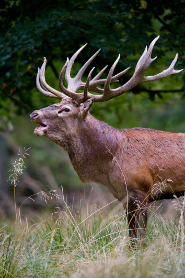 The Red Deer (Cervus elaphus) is one of the largest deer species in the world. Its remarkable size is amazing when you consider that most of its habitat encompasses many of Europe and Asia's coldest regions. This makes it interesting to study the Red Deer's habitat, its diet and its physical attributes.
The Red Deer (Cervus elaphus) is one of the largest deer species in the world. Its remarkable size is amazing when you consider that most of its habitat encompasses many of Europe and Asia's coldest regions. This makes it interesting to study the Red Deer's habitat, its diet and its physical attributes.The Red Deer's massive size is due in large part to its larger-than-normal physical attributes.
These attributes vary according to the gender of the animal. Stags are usually 175 to 230 cm (69 to 91 in) long and weigh anywhere from 160 to 240 kg (350 to 530 lb). Hinds tend to be 160 to 210 cm (63 to 83 in) long and weigh 120 to 170 kg (260 to 370 lb). Their tails are also unusually long. They tend to be 12 to 19 cm (4.7 to 7.5) in length.
Furthermore, it has one of the largest varieties of habitats in the world. The Red Deer is native to Europe, Asia Minor, the Caucasus Mountains and the Atlas Mountains in Africa. It also lives in Australia, New Zealand, South America because it was introduced into those areas by well-meaning humans. This wide geographic distribution has created unique habitats for the Red Deer. These habitats include woodland areas, forests and grasslands.
Its diet includes a variety of seasonal plants and grasses. Red Deer like to eat seasonal grasses, lichen, mosses and leaves off trees. If these foods are not available, Red Deer will also eat acorns, fruits and nuts that have fallen from trees. Stags will occasionally look for salt licks and other mineral deposits to keep their antlers in top condition.
They have several predators that keep healthier populations in check. The main predators of most Red Deer species are humans and domestic dogs. This is true because hunters in Europe, Asia and Africa enjoy hunting the Red Deer for sport and for food. The Red Deer also has to contend with wild wolves that tend to hunt for older or sicker animals. These predators have kept wild Red Deer populations in check throughout most of the world.
The Red Deer is also a semi-endangered species. This is because many sub-species of Red Deer are considered to be endangered species. This is the case because excessive hunting and habitat destruction have driven off many sub-species of Red Deer who live in Asia and Africa into untenable living areas.
Stags use this distinctive "roar" that is used to defend its territory and mates from possible invasion by other males.
Picture of the red deer by Bill Ebbesen, 26. september 2009 in Jægersborg Dyrehave in Denmark, licensed under Creative Commons Attribution 3.0 Unported
The Elk, red deer, wapiti is listed as Least Concern (LR/lc), lowest risk. Does not qualify for a more at risk category. Widespread and abundant taxa are included in this category, on the IUCN Red List of Threatened Species
Countries
Afghanistan, Albania, Algeria, Armenia, Austria, Belarus, Belgium, Bhutan, Bosnia and Herzegovina, Bulgaria, Canada, China, Croatia, Czech Republic, Denmark, Estonia, France, Georgia, Germany, Greece, Hungary, India, Iran, Ireland, Italy, Kazakhstan, Korea, North, Korea, South, Latvia, Lithuania, Luxembourg, Macedonia, Mexico, Mongolia, Morocco, Nepal, Netherlands, Norway, Pakistan, Portugal, Romania, Russia, Serbia and Montenegro, Slovakia, Slovenia, Spain, Sweden, Switzerland, Tajikistan, Tunisia, Turkey, Turkmenistan, Ukraine, United Kingdom, United States and UzbekistanElk, red deer, or wapiti habitats
Forest, Grassland, Mediterranean-type Shrubby Vegetation, Shrubland, Subtropical / Tropical Dry forest, Subtropical / Tropical Moist Lowland, Subtropical / Tropical Moist Montane, Temperate forest, Temperate Grassland and Temperate ShrublandSome facts about the
Red deer
Adult weight : 200 kg (440 lbs)
Maximum longevity : 32 years
Female maturity :852 days
Male maturity : 730 days
Gestation : 245 days
Weaning : 156 days
Litter size : 1
Litters per year : 1
Weight at birth : 10.1 kg (22.22 lbs)
Weight at weaning : 56.5 kg (124.3 lbs)
Basal metabolic rate : 112 W
Body mass : 67 kg (147.4 lbs)

Custom Search